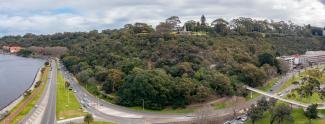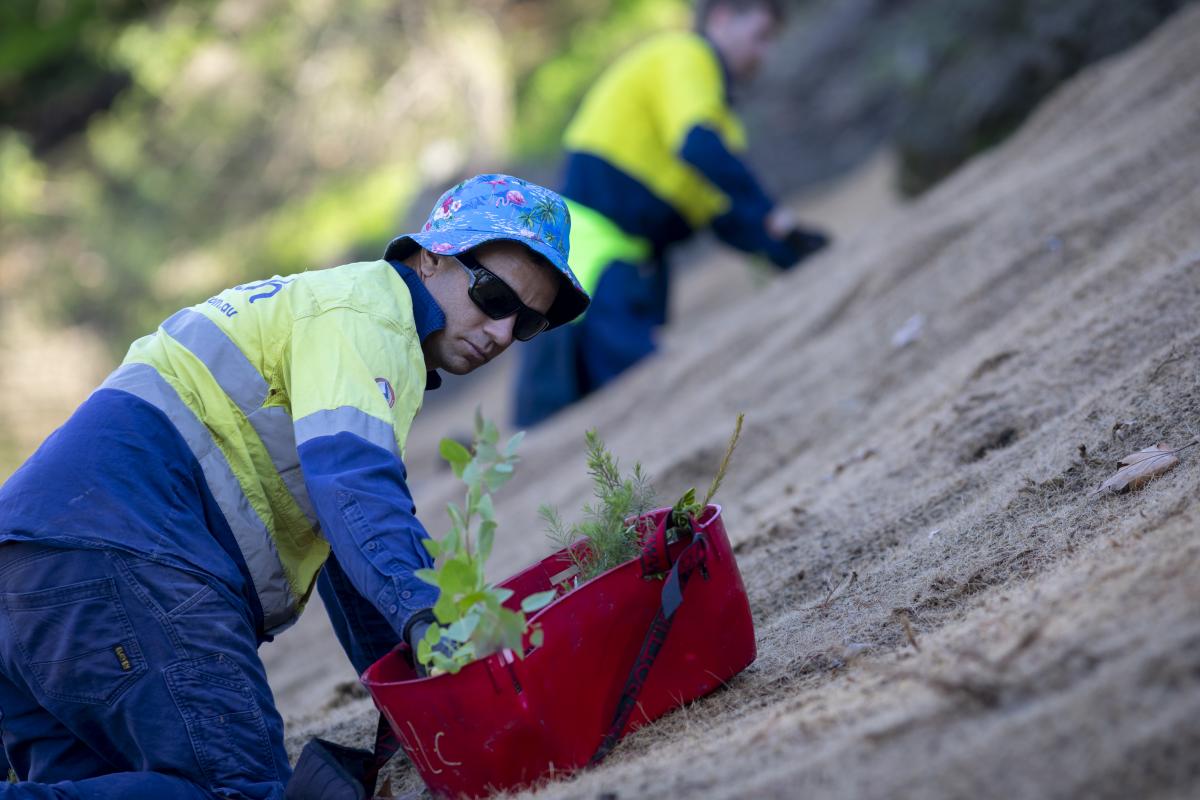Mount Eliza Escarpment Project
Mount Eliza Escarpment is in the process of transformation.
Updated October 2025.
Major works have now been completed as part of the Mount Eliza Escarpment project and our focus is shifting to on-going restoration activities.
Parts of the Mount Eliza Escarpment are now a different place following the Polyphagous Shot-Hole Borer response in Kings Park.
The deeply saddening discovery of the heavy beetle infestation required the removal of trees on the scarp in 2024-25 to protect the botanic garden, parkland and bushland of Kings Park.
Mounts Bay Gardens has seen a wonderful transformation take place, with the plants from 2024's planting thriving.
To address stabilisation concerns arising from the removal of the trees, Lover’s Walk has been demolished to allow for reshaping of the scarp to take place.
With the removal of the trail, there is no longer a connection between Kokoda Steps and Perth city. Please enter and exit Kings Park via Fraser Avenue or Jacob's Ladder.
Restoration work at the scarp
April 2025
A guide to scarp restoration work past and upcoming.
What is PSHB?
2021 saw the arrival of the declared pest Polyphagous shot-hole borer (PSHB) to the Perth region. PSHB is a beetle native to Southeast Asia. The beetle attacks a wide range of trees by tunnelling into trunks, stems and branches.
About the size of a sesame seed, PSHB excavates tunnels in trees where they cultivate a Fusarium fungus as a food source. This fungus spreads in the tunnels blocking the flow of water and nutrients in the tree. This blockage causes trees to become unsafe, and eventually die. If not removed, trees infested by PSHB can become a constant source of beetles that disperse and impact neighbouring trees.
Where to from here?
Mount Eliza escarpment is a special place in the hearts of Kings Park visitors and locals. The area is recognised for its significance to Whadjuk Noongar Traditional Owners as well as its post-colonial landscape features.
We have been greatly saddened at Kings Park to have to take this action to remove the trees, but we are already working on transforming the scarp back into a natural attraction for locals and visitors.
A total of around 60,000 trees and shrubs grown from seed collected from the scarp by the Kings Park team will be planted in stages from 2024 to 2026. These plantings are about building diverse, resilient landscapes which are prepared for climate and biosecurity threats into the future.
The scarp is being carefully managed with regular assessments, erosion control matting and logs, rock catch fencing, weed control and the new plantings. Consultation with traditional owners, geotechnical engineers and other stakeholders is ongoing.
Planting for the future
A key part of this restoration is replanting of the scarp with approximately 60,000 native plant species. In 2024, nearly 18,000 plants were grown and planted at Mounts Bay Gardens (Goonininup), including 500 trees, from 16 different species native to the scarp. In 2025, 20,000 plants have been planted between Kennedy Fountain and Kings Towers.
Species range in size from large eucalypts like Tuarts (E. gomphocephala) and Flooded Gum (E. rudis) to small ground cover species such as Running Postman (Kennedia prostrata) and Wattle (Acacia lasiocarpa). All the seed for these plants have been collected from the Mt Eliza escarpment.
Biosecurity and climate change are becoming greater challenges every day. Evidence shows that restoring ecological systems greatly improves resilience to these threats. Local flora species are much more resilient to threats as well as vital habitat and food for our native animals.
The PSHB fight continues
The program of tree removal and pruning is showing evidence of success.
DPIRD surveillance in Kings Park recorded a significant drop in PSHB presence in traps following the tree removals on Mt Eliza escarpment in March 2024.
Surveillance is ongoing at Kings Park and any additional infested trees will continue to be managed as appropriate, including removal if required.
Putting the focus on culture
BGPA and the Department of Primary Industries and Regional Development (DPIRD) recognise the significance of the area to Traditional Owners. All efforts have been made before, during and after the project to consult Whadjuk Noongar Traditional Owners and protect cultural heritage.
The next step seeks to create an environment that reflects the cultural sensitivity and environmental stewardship of Whadjuk Noongar culture, history, and values and reestablishes Mount Eliza escarpment as a meaningful connection between Kings Park and the Swan River.
Frequently Asked Questions
What Traditional Owner engagement has been undertaken?
BGPA and DPIRD recognise the significance of Mount Eliza Escarpment to the Whadjuk Noongar people and all efforts will be made to preserve the traditional heritage of the site.
- Goonininup – The freshwater spring is of significant spiritual heritage as it is associated with the home of the Rainbow Serpent, the Waugal. Its waters are considered sacred.
- Mount Eliza – The area was used as a gathering place for water, food, ceremony, communication, and trade.
BGPA engaged with the Whadjuk Aboriginal Corporation (WAC) to provide advice on the project operations. Through WAC, representatives from the Whadjuk Noongar community were, and continue to be, consulted by BGPA on the project.
BGPA will continue to engage with Traditional Owners as we look to the future of Mount Eliza and Mounts Bay Gardens (Goonininup) and protecting and celebrating its cultural heritage.
Is PSHB local to Kings Park?
DPIRD is responding to the confirmed detections in the Perth metropolitan area. BGPA is coordinating an internal response to limit spread of PSHB in Kings Park and into Bold Park. This involves a response by BGPA staff and volunteers, and working closely with our colleagues at DPIRD, DBCA and other key stakeholders.
We encourage everyone to be on the lookout for PSHB damage in their communities and to report observations of suspect borer activity.
What closures are in place?
Mounts Bay Gardens (Goonininup) is closed to pedestrian and vehicle access.
For visitor safety and to allow for essential restoration works to be undertaken, BGPA has demolished Lovers Walk. We understand that this will be disappointing to many park users and ask for understanding. Visitors will still be able to access Kokoda Steps from the top of the escarpment within Kings Park, but there will be no pedestrian access to the city from the base of the scarp.
A gate has been installed at the bottom of the Kokoda Track Memorial Walk to manage access.
Access to the park from the escarpment base will be via Jacob’s Ladder or Spring Street.
These closures will be in place for visitor safety and we thank you for your patience and understanding.
Will this affect the slope stability?
Recent assessments of the escarpment have indicated that the slopes have undergone relatively minor erosion and deterioration. BGPA is managing the increased instability risk presented by tree removals through ongoing consultation with GHD (geotechnical engineers), regular assessments, as well as erosion control works and revegetation. Public safety measures will be in place for the duration of the project, including exclusion zones and rock catch fences. An exclusion zone will remain in place at Mounts Bay Gardens (Goonininup).
What is being done to combat PSHB?
The Department of Primary Industries and Regional Development is managing the response to confirmed detections of PSHB.
Visit the DPIRD website for information on the beetle and biosecurity response.
How do I report PSHB?
Suspected PSHB sightings can be reported:
DPIRD Pest and Disease Information Service
MyPestGuideTM

